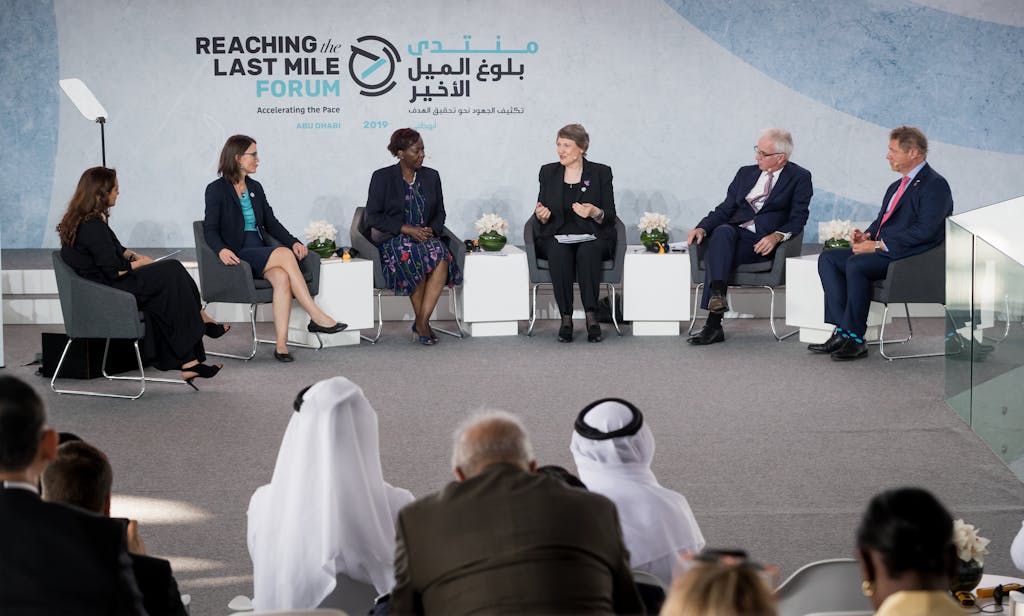“Polio, guinea worm and malaria are all symptoms of a deeper sickness. Which is why ultimately, our fight is not against a single disease. Our fight is against inequality.”
Those were the words of World Health Organization Director-General, Dr. Tedros Adhenom Ghebreysus at the recent Reaching the Last Mile Forum in Abu Dhabi where leaders and global health funders gathered to ensure no one is left behind in global efforts to eradicate diseases that strain health systems and economies. Without keeping the so-called “last mile” in mind as funding is allocated, global health targets are set, and programs are designed and implemented, we cannot achieve the goal of reaching everyone, everywhere with vital health services. And ensuring all people can access, quality and affordable health services is essential to one day conquering some of the biggest disease threats to everyone’s health and well-being. One of these threats that has plagued the world for far too long is polio.
We’ve managed to wipe out 99.9% of polio – an incredible achievement. But it will take all of us, working together, to finish the job. Eradicating only the second human disease in history will be a health success story and an example of the value of collective action to achieve global goals.
During the Reaching the Last Mile Forum, donors and global leaders demonstrated just what collective action can do. Together, during the Forum they pledged $2.6 billion to ensure we can finish the fight against polio and once and for all achieve eradication. As part of this effort, the UN Foundation and our Shot@Life campaign pledged to contribute roughly $1.6 million per year over the next three years to the Global Polio Eradication Initiative.
Additionally, key private sector partners like Takeda Pharmaceuticals promised to give approximately $5 million to the African Region over the next five years to bolster the broader surveillance infrastructure that is needed to stop a range of vaccine-preventable diseases, including polio. Takeda hopes that this first pledge for vaccine-preventable diseases surveillance will encourage other donors to consider this critical area of work, which often goes overlooked.
These pledges, among others made at the Forum, demonstrate the impact innovative partnerships between donors and governments can have to ensure we can successfully bridge critical funding gaps.
Investing in hope; Investing in history.
“We are grateful for the generous pledges made today and thank governments, donors and partners for standing with us to end polio,” said Dr. Tedros. “But they are not just pledging money. They’re investing in health. They’re investing in hope. They’re investing in history.”
However, these funds are only a part of the estimated $4.27 billion needed to achieve the Global Polio Eradication Initiative’s Polio Endgame Strategy. If we are truly going to move closer to achieve health and well-being for all, it is imperative country and private sector donors alike answer the call for funding needs.
We know that there are still very real challenges ahead in the road to achieving global polio eradication. Pakistan and Afghanistan (the two countries where wild polio remains), face infrastructure issues, violence and instability, and a lack of trust in health systems. Rare mutations of the poliovirus, known as circulating vaccine-derived poliovirus (cVDPVs), which can cause paralysis in under-vaccinated populations, have also been seen in multiple countries over the last year.
These challenges are not easily addressed and require robust political will, community engagement, and significant financial resources to ensure a polio-free future can be achieved, even in extremely difficult country contexts.
We know that our progress on health is fragile. It’s up to us to protect it. By committing to work collaboratively to ensure polio can one day soon be a thing of the past, we continue to promise to stay the course and truly go the last mile.



 View All Blog Posts
View All Blog Posts


